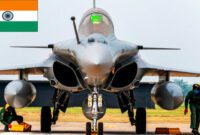The Dassault Rafale is listed as the aircraft that beat the F-16-In the late 1970s, France faced a dilemma. The international effort to build a suitable fighter aircraft did not meet its needs, prompting France to embark on the ambitious journey to develop its own fighter jet. Thus, the Dassault Rafale was born, a testament to French ingenuity and determination.
A History of Innovation

The Rafale emerged at a time of strategic uncertainty during the Cold War. With limited visibility into Soviet capabilities, Western nations, including France, focused on versatile multi-role aircraft. While the U.S. developed the F-16 and F-15, Europe sought a collaborative effort resulting in the Eurofighter Typhoon. France, however, had its sights set on a fighter that could fulfill both Air Force and Navy requirements, leading to the birth of the Rafale.
Dassault Rafale Technological Prowess
The Rafale’s design reflects its multi-role capabilities. Weighing about 10 tons, it can carry a variety of payloads, including air-to-air missiles and guided munitions, with a combat range of 1,850 kilometers. Equipped with advanced radar, electronic warfare systems, and a long-range opto-electronic system, the Rafale boasts unmatched target tracking and engagement capabilities.
Operational Success
Since its introduction, the Rafale has proven its mettle in combat zones worldwide. From supporting NATO troops in Afghanistan to strikes in Libya, the Rafale has showcased its superior combat capabilities. Notably, during the Libyan conflict, the Rafale’s advanced onboard systems allowed it to operate independently of electronic warfare support, a testament to its technological superiority.
A Leading Fourth-Generation Aircraft
Despite the absence of stealth technology, which defines fifth-generation fighters, the Rafale stands out as a leader among fourth-generation aircraft. Its agility, avionics, and electronic warfare capabilities give it an edge over competitors like the F-16, Su-35, and Eurofighter Typhoon in air-to-air combat and multi-role operations.
Dassault Rafale Future Prospects
As the Rafale continues to serve the French military and international customers, upgrades like the F4 version ensure it remains at the forefront of combat innovation. With ongoing discussions on enhancing its stealth capabilities, the Rafale’s future looks promising, cementing its status as a formidable force in the global aviation landscape.
In conclusion, the Dassault Rafale is not just a fighter jet; it’s a symbol of French innovation and a testament to the nation’s commitment to defending its interests. As it continues to soar through the skies, the Rafale stands tall as a beacon of technological excellence in the world of combat aviation.
- France faced a dilemma in the late 1970s when it needed a new fighter aircraft but couldn’t find one suitable for its needs, leading to the development of the Dassault Rafale.
- The Rafale was designed to be a highly capable omnirole fighter, capable of both air-to-air and air-to-ground missions, day and night, in all weather conditions.
- Initially, there were attempts at international collaboration, but France eventually pursued the development of the Rafale independently, leading to its first flight in 1986.
- The Rafale comes in three variants: Rafale A (prototype), Rafale B (Air Force), and Rafale M (Naval), each tailored for specific operational requirements.
- With advanced avionics, electronic warfare systems, and superior agility, the Rafale has proven itself in combat zones, including missions in Afghanistan, Mali, and Syria, making it a formidable competitor against other modern multi-role fighters like the F-16, Su-35, and Eurofighter Typhoon.



